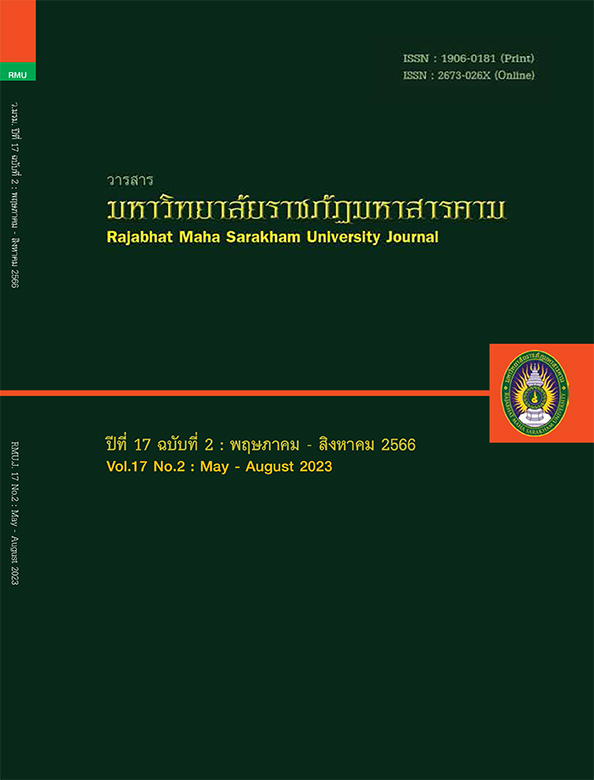โครงสร้างกรรมวาจกที่ไร้ผู้กระทำในนวนิยายอังกฤษ
Main Article Content
บทคัดย่อ
งานวิจัยนี้เป็นการศึกษาการใช้โครงสร้างกรรมวาจกที่ไร้ผู้กระทำในนวนิยายอังกฤษ แม้จะมีงานวิจัยที่ได้ทำการศึกษาโครงสร้างกรรมวาจกที่ไร้ผู้กระทำก่อนหน้านี้ให้ความสำคัญกับงานเขียนของผู้เรียนภาษาอังกฤษเป็นภาษาต่างประเทศและงานเขียนของผู้เรียนภาษาอังกฤษเป็นภาษาที่สอง งานวิจัยครั้งนี้จึงเลือกตัวบทที่แตกต่างออกไปคือนวนิยายภาษาอังกฤษ ชุดข้อมูลเก็บมาจากนวนิยายอังกฤษ ที่มียอดขายสูงเป็นจำนวนทั้งสิ้นเจ็ดเล่ม (www.amazon.com) ชุดข้อมูลนวนิยายทั้งหมดประกอบด้วย Little Woman (Alcott, 2019) the Adventures of Sherlock Holmes (Doyle, 2019) Frankenstein (Shelley, 2019) Northanger Abbey (Austen, 2019) Treasure Island (Stevenson, 2019) Mrs Dalloway (Woolf, 2021) และ a Portrait of the Artist as a Young Man (Joyce, 2021) ชุดข้อมูลจำนวนประมาณ 350,000 คำจากนวนิยายทั้งสิ้นเจ็ดเล่มประกอบด้วย 30 ตัวอย่างของโครงสร้างกรรมวาจกที่ไร้ผู้กระทำในนวนิยายอังกฤษ การวิเคราะห์โครงสร้างกรรมวาจกที่ไร้ผู้กระทำตามแบบของ Swan (2016) นักภาษาศาสตร์ภาษาอังกฤษจำนวนทั้งสิ้นสามท่านดำเนินการตรวจสอบความถูกต้องของการวิเคราะห์ข้อมูล ผลการศึกษาในงานวิจัยนี้แสดงให้เห็นว่าร้อยละ 56.67 ของการใช้โครงสร้าง กรรมวาจกที่ไร้ผู้กระทำที่พบในนวนิยายภาษาอังกฤษเป็นเพราะทราบอยู่แล้วว่าใครคือผู้กระทำ ร้อยละ 33.33 พบว่าไม่ทราบว่าใครเป็นผู้กระทำและร้อยละ 10 แสดงให้เห็นว่าผู้กระทำนั้นไม่มีความสำคัญ นักวิจัยหวังเป็นอย่างยิ่งว่าผลการศึกษาของงานวิจัยครั้งนี้จะเพิ่มพูนความรู้ด้านโครงสร้างกรรมวาจกที่ไร้ผู้กระทำในนวนิยายอังกฤษซึ่งจะเป็นประโยชน์ต่อผู้เรียนภาษาอังกฤษเป็นภาษาต่างประเทศและผู้เรียนภาษาอังกฤษป็นภาษาที่สองในการเขียนโครงสร้างกรรมวาจกที่ไร้ผู้กระทำในนวนิยายอังกฤษอย่างถูกต้องและเหมาะสม
Article Details

อนุญาตภายใต้เงื่อนไข Creative Commons Attribution-NonCommercial-NoDerivatives 4.0 International License.
1. บทความที่ลงตีพิมพ์ทุกเรื่องได้รับการตรวจทางวิชาการโดยผู้ประเมินอิสระ ผู้ทรงคุณวุฒิ (Peer Review) สาขาที่เกี่ยวข้อง อย่างน้อย 3 ท่าน ในรูปแบบ Double blind review
2. ข้อคิดเห็นใด ๆ ของบทความที่ลงตีพิมพ์ในวารสารมหาวิทยาลัยราชภัฏมหาสารคาม นี้เป็นของผู้เขียน คณะผู้จัดทำวารสารไม่จำเป็นต้องเห็นด้วย
3. กองบรรณาธิการวารสารมหาวิทยาลัยราชภัฏมหาสารคาม ไม่สงวนสิทธิ์การคัดลอกแต่ให้อ้างอิงแสดงที่มา
เอกสารอ้างอิง
Alotaibi, A. M., & Alajmi, H. (2015). The acquisition of The passive alternation by Kuwaiti EFL learners. International Journal of English Linguistics, 5(1), 44.
Austen, J. (2019). Northanger Abbey. UK: Chiltern.
Bakhshandeh, S., & Jafari, K. (2018). The effects of input enhancement and explicit instruction on developing Iranian lower-intermediate EFL learners’ explicit knowledge of passive voice. Asian-Pacific Journal of Second and Foreign Language Education, 3(1), 1-18.
Blanco-Gómez, M. L. (2002). Hiding the agent in English and Spanish newspaper articles: The periphrastic passive. Conceptualization of events in newspaper discourse: Juana I. Marin Arrese (ed.). In Mystification of agency and degree of implication in news reports (pp. 9-30). Universidad Complutense de Madrid
Doyle, A. C. (2019). The Adventures of Sherlock Holmes. UK: Chiltern.
Etikan, I., Musa, S. A., & Alkassim, R. S. (2016). Comparison of convenience sampling and purposive sampling. American Journal of Theoretical and Applied Statistics, 5(1), 1-4.
Joyce, J. (2021). A protrait of the artist as a young man. UK: Chiltern.
Jung, W. H. (2006). Error Analysis: What problems do learners face in the production of the English passive voice?. English language & literature Teaching, 12(2), 19-40.
Halik, A. F. A. & Kareema, M. I. F. K. (2020). Difficulty faced by EFL learners in using English passive voice in written communication: A study based on the students of NAITA, Trincomalee, Sri Lanka. KALAM-International Research Journal, 13(3). 51-59.
Mathieson, P. (2017). Secret agents and innocent patients: The mysteries of the English passive voice and its use (and misuse) in EFL writing in Japan. Journal of Pan-Pacific Association of Applied Linguistics, 21(2), 1-13.
Radford, A. (2009). Introduction to English sentence structure. Cambridge: Cambridge University Press.
Scholastica, C. A. (2018). Learning the English passive Voice: Difficulties, learning strategies of Igbo ESL learners and pedagogical implications. International Journal of English and Literature, 9(5), 50-62.
Sogus, S. A. (2018). Ideology in the news through active, passive and nominalization: A study on the terrorist attack in Ankara reported in British and American newspapers. Journal of Language and Linguistic Studies, 14(1), 162-177.
Somphong, M. (2013). An analysis of errors in passive sentence structures by Thai EFL university students. The Asian Conference on Education 2013: Official Conference Proceedings. 662-675.
Stevenson, R. L. (2019). Treasure Island. UK: Chiltern.
Subagio, U., Prayogo, J. A., & Iragiliati, E. (2019). Investigation of passive voice occurrence in scientific writing. International Journal of Language Teaching and Education, 3(1), 61-66.
Swan, A. (2016). Practical English use. Oxford: Oxford University Press.
Woolf, V. (2021). Mrs Dalloway. UK: Chiltern.


